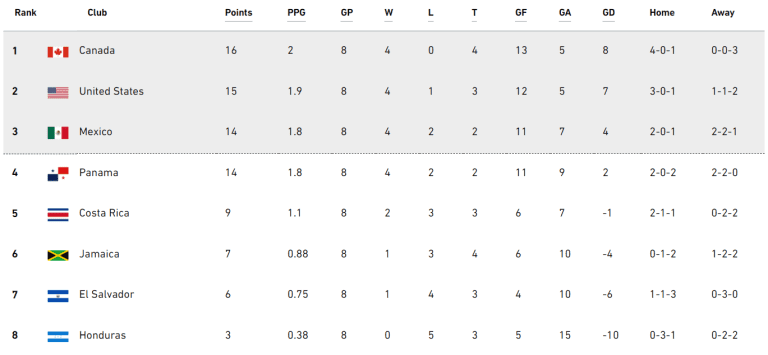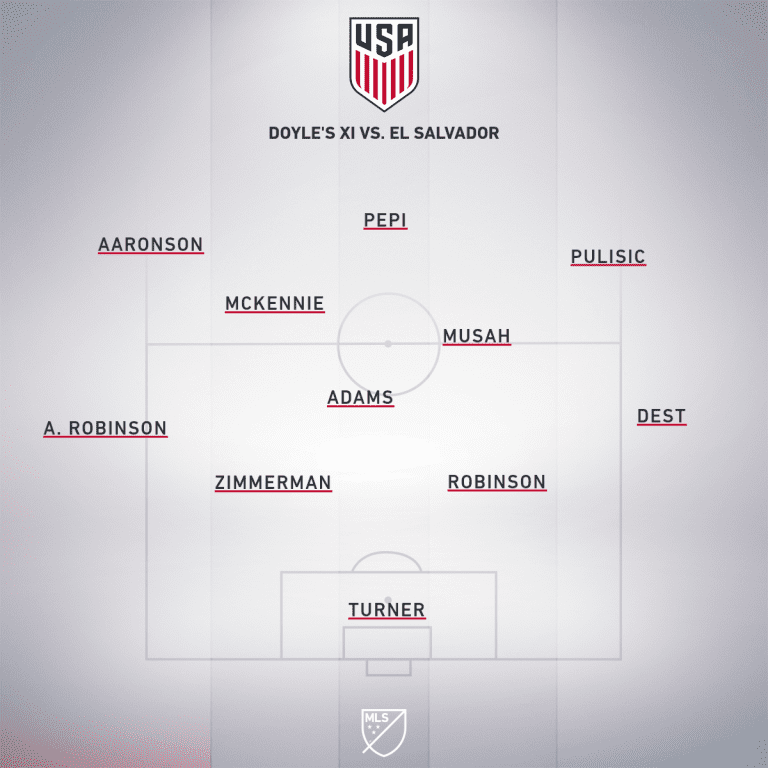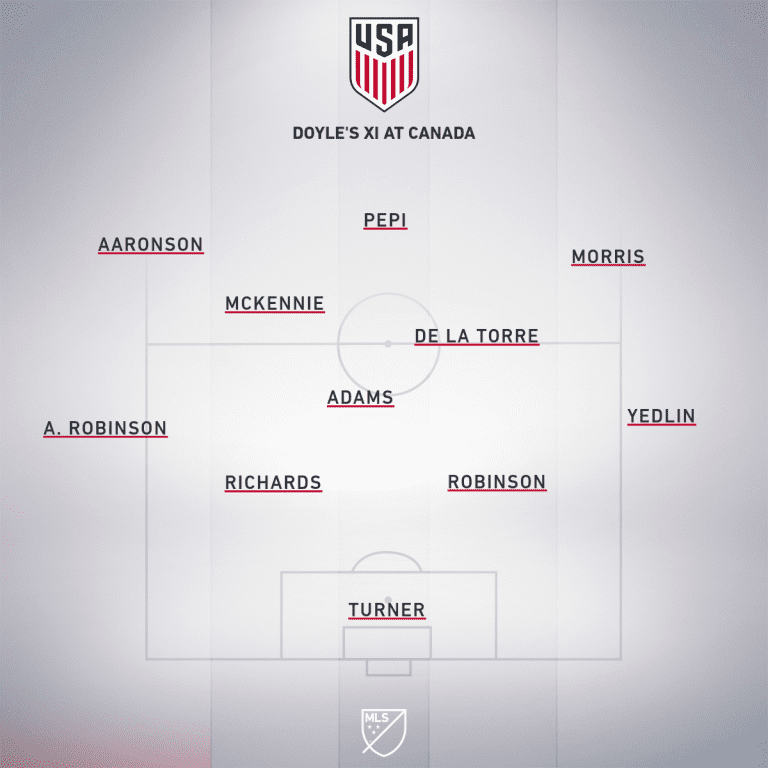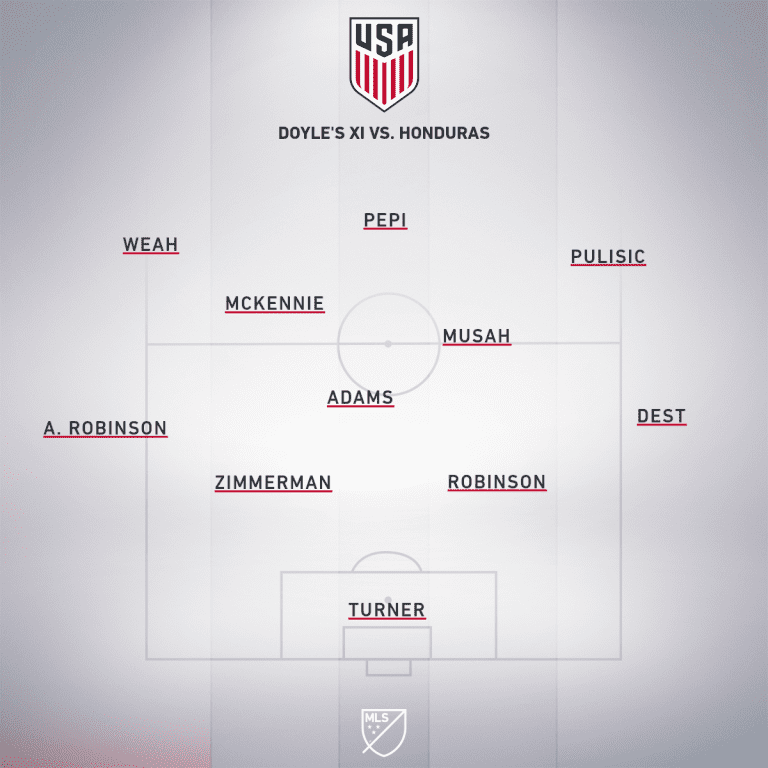We are now staring at the penultimate international date for 2022 Concacaf World Cup Qualifiers.
The US men’s national team and everyone else left standing in Concacaf passed the midway point back in November, each having completed eight of the 14 games comprising the Octagonal.
And just in case you’ve forgotten how things look, here’s a quick snapshot of the table:

It has not been perfect from the US – far from it. But with six games left, they are in complete control of their own destiny. They have, to this point, done the job.
And now for the next part, during which they must continue to do the job: three rapid-fire games over the course of this coming week, a sequence that could conclude with the US having all but punched their ticket for Qatar. Nine or, frankly, even seven points doesn’t get the US in mathematically, but it puts them in “would need an even bigger disaster than Couva to actually miss it” territory.
Conversely, this sequence of games could also leave the US in something close to shambles. It shouldn’t, mind you, as the US have massive talent advantages over both El Salvador and Honduras, and six points from those two home games puts the US in a strong position entering the final slate of qualifiers no matter what happens up in Canada this weekend.
But “shouldn’t” is a dangerous word. The US shouldn’t have lost in Couva four years ago – they had a massive talent advantage in that game, too. Eight years ago, Panama shouldn’t have melted down with a 1-0 home lead over the US, but they did, losing 2-1 and letting Mexico slip into Brazil through the back door. Four years before that Costa Rica shouldn’t have conceded a 95th-minute equalizer to Jonathan Bornstein, letting the US rally back from a 2-0 deficit for a 2-2 draw that put the US atop the Hexagonal and knocked the Ticos down to fourth. Honduras climbed up to third thanks to that result and automatically qualified for South Africa. Costa Rica had to face Uruguay in a playoff, and that was as close as they got to the 2010 World Cup.
My point is that strange, program-changing things can happen in qualifying, especially on the last day. You know how you avoid those sorts of dramatics? By taking care of business in the middle of the qualification cycle, especially when you’re at home and especially when you’re facing teams you should beat.
So, continue to do the job. I would like to watch the final Ocho qualifiers two months from now relaxed and half-drunk instead of anxious and half-dead from nerves. A good week here from the US could virtually guarantee that.
Opponent brief
Hugo Perez, a USMNT legend and erstwhile US youth national team coach, has done great work with La Selecta. They have recruited dual-nationals, re-invigorated a bunch of the veterans who’ve led the program during a mostly barren past dozen years, promoted young players and – most importantly – instilled a true tactical identity, one that plays to the strengths of the player pool.
That identity: we want the ball, and then we want to do something pretty with it to break you down.
It has been spectacular to watch this team over the course of Perez’s tenure go from a tentative minnow to a side that will literally go to Mexico and try to out-possess El Tri. And at times they’ve done it! They play with zero fear and complete clarity of vision, and it has produced some truly great soccer over the past eight months.
Usually that beautiful possession soccer comes out of a 4-4-2 diamond. It asks a lot of the shuttlers, who have to be everywhere lest the d-mid gets overloaded at one moment, then the fullback the next, and “a lot” has often been too much. For as beautiful as El Salvador have played, they have frequently been blown up by teams that can stretch the field horizontally from touchline to touchline, and by teams that can just outrun them in transition.
And so this is how their games unfold: That clarity of vision means Perez’s side have often come out on the front foot and controlled the first half. But the energy expenditure, as well as the collective talent and athleticism gap, means they’ve struggled to see those games out, and have been outscored 7-1 in the second halves during the Ocho.
Also, note that set pieces should be a huge US advantage. And my word are the US due to bag one on a restart.

US lineup notes
• Canada is nominally the toughest game this week. But I will always be more concerned about taking full home points, so a full-strength XI it is.
• The one minor quibble could be Brenden Aaronson over Tim Weah, but Weah’s only just coming back to fitness and I don’t particularly want to risk his hamstrings for 90 minutes in any of these games, so Aaronson gets the start and Weah’s the super-sub.
• I have written before that I prefer Christian Pulisic as a right winger because I think he plays more simply when he’s there, and Pulisic is a better player when he’s a simpler player. Put him on the left and he’ll just invert and dribble straight into the hurt locker a million times again.
That said, I do think he’ll start on the left for the US this week. It’s not the choice I’d make but that just seems to be how it is.
• Chris Richards is a better distributor than either Walker Zimmerman or Miles Robinson, but he’s not as good in the air. And I want the US to just destroy El Salvador in the air on restarts, so that’s that.
• Zack Steffen’s back injury makes starting Matt Turner an easy call for me. I wonder if, now that Arsenal have logged something close to a $10 million bid for Turner, I will get less flack from certain corners of the internet for rating Turner over Steffen all along?
• The US have to be prepared to come out on the front-foot and push the hell out of the game. If they won’t, El Salvador will, and the last thing you want to do in a situation like this is give an out-matched opponent early life.
Opponent brief
John Herdman has, I think, pulled more correct levers in qualifying than any other coach in Concacaf with the possible exception of Panama’s Thomas Christiansen. It hasn’t been flawless – the YOLO lineup against Honduras way back in September was a mistake, and I didn’t think he got the tactics right at Jamaica on Matchday 5. But other than that it’s hard to point to any obvious mistakes.
And what he’s done right hasn’t been just rolling out the same group over and over. Herdman has changed lineups, formations and even principles of play. In a 1-1 draw at the US back in September, Canada drew a line of confrontation about 30 yards from their goal, had about 25 percent possession and dared the US to leave space in behind for the counter. Even with so little of the ball, they controlled how and where the game was played and were the better team on the day.
A month later they went to the Azteca and stood toe-to-toe with Mexico, collecting nearly 50 percent possession, gashing El Tri with quick builds through the middle and once again coming away with a 1-1 draw. A month after that they hosted Mexico in frigid Edmonton and basically played the visitors off the pitch, winning 2-1 (the scoreline flattered El Tri).
Herdman has turned this team into a super-effective chamaeleon, and fear of the Canadian attack has papered over some weaknesses in their defense. Teams are understandably reluctant to throw numbers at that backline.
Here is the rub: Herdman has not had to go deep into the roster over the first eight games. Canada have been significantly healthier than most teams and have avoided injuries. But that’s not the case now, as they will be without left winger/wingback/back/playmaker Alphonso Davies for all three of these games, and without central midfielder Stephen Eustaquio for the first two (according to reports, anyway – be aware Herdman is entirely capable of dark arts-related media misdirects).
Davies is the best player in the region by a mile, and Eustaquio is probably the irreplaceable man in midfield. If he’s not out there it’s much harder to imagine Canada tick-tocking a good team to death like they did to Mexico, and kind of limits the amount of shape-shifting Herdman can do.
Even with those absences Canada could very easily drop three on the US, mind you. Jonathan David, Cyle Larin and Tajon Buchanan are all Champions League attackers, and the midfield, even without Eustaquio, remains quite good.
But still, they’ll be without their two most important players. That’s a lot for any team to deal with.

US lineup notes
• Four changes from the Game 1 group, barring injuries or catastrophic loss of form. I don’t love the idea of playing Tyler Adams in three straight games, and could be talked into James Sands at d-mid if he was here. But he’s not and Kellyn Acosta is, and I am wary of starting Acosta as the 6 in a road qualifier after what happened in Panama.
Adams has gone big minutes in three-game windows before. I’m going to ask him to do it again this time, as well as Weston McKennie.
• I am not going to ask the same of Yunus Musah, instead turning to Luca de la Torre. He plays in a lower-level league than MLS but he is in-season, and he excels at the precise things (ball progression and tempo-setting) that guys like Acosta and Sebastian Lletget have struggled with when asked to play as the No. 8.
I am excited to see more of him. I hope he gets a start this week.
• DeAndre Yedlin over Dest on the road is an easy call.
• Jordan Morris gets the start because I want a goal-scoring winger out there and am not willing to risk Pulisic’s hamstrings with three straight starts.
• Richards is probably better in the open field than Zimmerman, so he partners Miles in this game.
• It’s crazy to me Antonee Robinson is the only natural left back on this roster. I know Gregg Berhalter has said other guys in the group can play that spot, but I’ve not seen any of them play it well. Let’s hope he can hold up over the course of this window, or that my assessment of the quality of his possible back-ups on this roster is wildly off-base.
• I’ve got Ricardo Pepi starting again, and I’m of the opinion he should keep starting until he plays himself out of the job. That said, the way to get at Canada is to move those center backs around, so I could see Berhalter being very clever and using Jesus Ferreira as a type of false 9 (though I think both Gregg and Jesus would quibble with that designation).
It’s not a move I would make – I generally hate the false 9 as a concept. But Pepi is a guy who most often plants himself near the center backs and tries to get off the shoulder or just physically occupies them. Ferreira, when he plays as a 9, comes back into the midfield and links play, causing the opposing center backs and central midfielders to make very hard choices about who goes with him. That can break a team’s shape, and if I’m a US fan I like the idea of Steven Vitoria chasing the No. 9 all over creation.
But again: I wouldn’t do it. There is, however, a theoretical reason my position is dumb.
Opponent brief
Honduras are who they’ve always been (physically hard bordering on brutal, and dangerous on the counter), but worse. They are winless (0W-5L-3D) and dead last on just three points, and have been so bad that they changed coaches after Matchday 6, hiring Colombian Hernan Dario Gomez.
El Bolillo’s teams (he’s coached a lot of them, including Panama and Guatemala in Concacaf) have never really played. They have mostly been grit-and-grind, and grit-and-grind does, in general, seem to suit this Honduran group more than anything more expansive.
Even so, Gomez had an absolutely brutal debut window back in November. In Matchday 7 Los Catrachos blew a 2-0 home lead by surrendering goals in the 77th, 80th and 85th minutes to visiting Panama for the 3-2 loss – among the worst World Cup qualifying losses I have ever seen in any federation, in any context. They followed that up by going to Costa Rica and conceding in the 95th minute to lose 2-1 to the fourth-place Ticos.
It’s worth noting, though, this window is the first time in qualifying that Honduras have had all three of Alberth Elis, Romell Quioto and Anthony Lozano all healthy and available. Those guys can counter anyone to death.
Of course, they might not factor against the US. I expect Honduras to empty their tanks in their first two games of this window, which are home against Canada and El Salvador respectively, and for them to not have much left for the third game. That is a pretty well-established pattern for Central American teams during these three-game windows: they are just out of gas by game three.
The numbers back that up. The four Central American teams are a combined 0W-6L-2D with a -14 goal differential in the third game of these three-game windows.

US lineup notes
• Barring injuries/suspensions, I do think this one picks itself – though I could see Berhalter choosing not to risk Miles Robinson for three straight games and going with Richards instead.
• The other argument for Richards is his ability to pick a pass would be more valuable against a packed-in Honduras side. I won’t complain if he starts over either Zimmerman or Robinson for that reason; there is an obvious logic to it.
• The Honduran center backs are physical as hell, but not particularly big, strong or intimidating. Which is to say I don’t think Pepi will get ragdolled and bossed out of the game like he did against Jamaica or this past weekend against Bayer Leverkusen, though if he does I am perfectly fine with the notion of Gyasi Zardes coming in to save the day. That is, I think, the one thing that could unite a divided fanbase.












